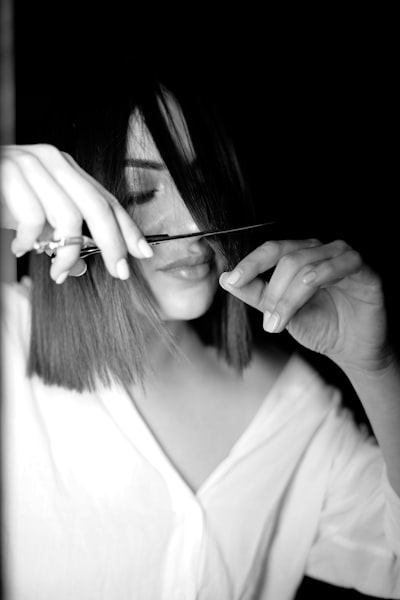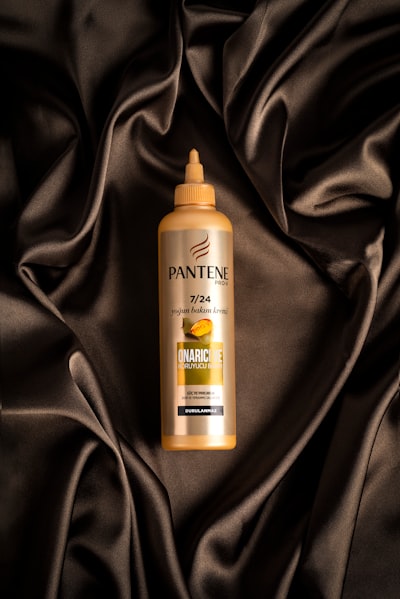Restore Damaged Hair from Bleach Breakage
Bleaching hair has become a popular trend, allowing individuals to experiment with vibrant colors and unique styles. While bleach can undoubtedly transform your hair, it can also cause significant damage if not properly cared for. The hair shaft and cuticle, which protect the hair, can suffer from bleach damage, resulting in dryness, breakage, and overall hair damage. However, there are steps you can take to repair and restore your hair after bleach damage. In this blog, we will discuss the signs of bleach damage, common mistakes that lead to hair damage, the role of hair extensions in hair restoration, the downside of excessive keratin use, practical steps for repairing bleached hair, tips to prevent further damage, and whether it is possible to fully restore bleached hair. Let's dive into the world of hair care and restoration, and discover how you can bring your damaged hair back to life.

 Understanding Damaged Hair from Bleach
Understanding Damaged Hair from Bleach
Bleach-damaged hair occurs when the hair shaft, which consists of the hair cuticle, is compromised. The hair cuticle, a protective layer, is responsible for sealing in moisture and keeping the hair shaft intact. However, bleach can strip away natural oils and pigment, leaving the hair dry, brittle, and damaged. Bleach has been one of the largest culprits causing hair damage, and the need to restore hair to normal utilizing hair extension!

Signs of bleaching damage
When bleaching hair, it's essential to be aware of the signs that indicate damage. Dry hair, hair breakage, brittle hair, and hair damage are all common side effects of bleach damage. You may notice hair breakage or hair loss after bleaching, which can be a significant sign of bleach damage. Additionally, dryness, frizz, and a lack of elasticity in the hair are indicators of bleach damage. If you experience hair breakage, split ends, or damage to the hair cuticle, your hair has likely been damaged by bleach.

Differentiating between bleach and heat damage
While bleach damage and heat damage can have similar effects on the hair, it's crucial to differentiate between the two. Bleach damage occurs when the hair shaft is compromised due to the chemical bleaching process. On the other hand, heat damage is caused by excessive use of heat styling tools, such as hair dryers, straighteners, and curling irons. One way to differentiate between bleach damage and heat damage is to look for hair color loss. If you notice a significant loss of hair color after bleaching, it's likely a result of bleach damage.

Common Mistakes Leading to Hair Damage
To prevent further damage to your hair, it's essential to avoid common mistakes that can worsen the condition of bleach-damaged hair. By being aware of these mistakes, you can provide the best care for your hair and facilitate the restoration process.


Misuse of hair care products
One mistake often made is the misuse of hair care products. It's crucial to select hair products that are specifically designed to repair bleach-damaged hair. Look for products that nourish and hydrate the hair, helping to restore its natural strength and resilience. Avoid products that contain harsh chemicals that may further damage the hair or scalp.
Here are a few bullet points to consider:
- Opt for hair products that repair bleach-damaged hair.
- Choose products designed for hair repair and hydration.
- Employ hair products that restore natural pigment and hydration.

Overuse of heat styling tools
Another common mistake is the overuse of heat-styling tools. Excessive heat can damage the hair, especially when used without proper precautions. While it may be tempting to style your hair frequently, it's important to limit the use of hot tools to prevent further damage. Using heat-protectant products can also help shield your hair from heat damage.

Neglecting regular haircut
Neglecting regular hair trims is a mistake that can exacerbate bleach-damaged hair. When hair becomes damaged, the ends may split or break, which can result in further damage to the hair. Scheduling regular trims allows a stylist to remove damaged ends, promoting healthy hair growth and preventing further breakage.
The only way to promote healthy hair growth is by allowing enough time for your hair to grow. Avoid future chemical processes for a few months.

 Scalp Massage to Promote Blood Circulation
Scalp Massage to Promote Blood Circulation
A simple yet effective way to promote hair health is by incorporating scalp massages into your hair care routine. Scalp massages help stimulate blood circulation, which nourishes the hair follicles and promotes healthy hair growth. Use your fingertips to gently massage your scalp in circular motions for a few minutes each day. This relaxing technique not only feels great but also supports the overall health of your hair and scalp.
Remember to be gentle as excessive force can cause further damage. Incorporating essential oils like peppermint or lavender can provide additional benefits, as they have been known to promote relaxation and stimulate the scalp.

Moisture Inducing Shampoo & Conditioner
An old faithful product line is Nexxus Humectress - it is an affordable product that helps to infuse moisture into your strands. This moisture-inducing shampoo and conditioner can work wonders for your damaged hair. The key to repairing bleach-damaged hair is replenishing it with much-needed moisture, and the Nexxus Humectress line does just that. These products are formulated to deeply hydrate your strands, leaving them soft, smooth, and nourished.

Role of Hair Extensions in Hair Restoration
Hair extensions can play a significant role in the restoration of damaged hair. They provide a temporary solution to hide hair damage while allowing your natural hair time to recover and grow.
Benefits of hair extensions for damaged hair quickly
Hair extensions offer several benefits for those with damaged hair. By using hair extensions, you can achieve a new hairstyle without further damaging your bleached hair. They also add a protective layer to damaged hair, helping to prevent further breakage. Furthermore, hair extensions can boost your hair's volume and length, giving you the confidence to flaunt a healthy-looking mane.

Precautions while using extensions on damaged hair
While hair extensions can be a valuable tool in restoring damaged hair, it's essential to take precautions to ensure the health and well-being of your natural hair. Avoid further damage by choosing lightweight hair extensions that do not put unnecessary strain on the hair. Also, maintain moisture levels in the hair by regularly deep conditioning and using products specifically designed for hair extensions. Finally, care for your natural hair underneath the extensions by following a gentle hair care routine and keeping the scalp nourished.
Keratin Overuse: A Hidden Threat
Keratin treatments have gained popularity as a way to repair damaged hair, but excessive use can have adverse effects. It's important to understand the potential downsides of using keratin products to restore bleach-damaged hair.
The downside of excessive keratin
While keratin products can help strengthen and repair hair, overuse can lead to hair breakage and damage. Excessive keratin use can make the hair too rigid, causing it to become brittle and prone to breakage. Additionally, overusing keratin products may result in a loss of natural pigment, affecting the hair's color and appearance.
Practical Steps for Repairing Bleached Hair
Repairing bleached hair requires a comprehensive approach that encompasses proper care and nourishment. Let's explore some practical steps you can take to restore your hair's health and vitality.
The Relevance of a Healthy Diet
Maintaining a healthy diet is essential for repairing bleach-damaged hair. A well-balanced and nutritious diet can promote hair repair, growth, and overall hair health. Including foods rich in vitamin E, amino acids, and essential fatty acids, such as avocado, olive oil, and aloe vera, can help repair damage caused by bleaching. These nutrients nourish the hair, providing hydration, and promoting healthy hair growth. Additionally, a healthy diet supports the repair process, preventing further damage caused by bleaching.
Tips to Prevent Further Damage
Preventing further damage to bleached hair is crucial to facilitate its repair and restoration. By following a few simple tips, you can protect your hair from unnecessary damage and maintain its health and vitality.
Avoid Swimming in Chlorine
The best way to care for your hair is to avoid chlorine, or wearing a bathing cap when swimming - damaged hair may turn green and break further. Cover your hair to prevent UV rays from reaching your hair.
Opt for gentle hair ties
Hair ties can often lead to hair breakage, especially when used improperly or with excessive tension. Opting for gentle hair ties, such as silk scrunchies or fabric hair bands, can minimize the risk of breakage and damage to bleached hair. These hair ties reduce tension, allowing the hair to maintain its natural elasticity and strength, while also preventing frizz and breakage. Taking this simple step in hair care can significantly impact the overall condition of your bleached hair.

Is it Possible to Fully Repair Bleach Damaged Hair?
While fully restoring bleached hair to its pre-damaged state may be challenging, it is possible to significantly improve its condition with the right care and attention. Patience, persistence, and consistency in hair care routines are vital for achieving the best results.
 Conclusion
Conclusion
Restoring hair after damage from bleach is a process that requires patience, care, and the right techniques. By recognizing the signs of bleach damage, differentiating it from heat damage, and avoiding common mistakes, you can take the first steps toward restoring your hair's health. Hair extensions can also play a role in the restoration process, providing benefits for damaged hair when used correctly. However, it's important to be cautious and not overuse keratin, as excessive use can cause further damage. To repair bleached hair, focus on maintaining a healthy diet and following practical steps, such as using gentle hair ties and preventing further damage. While full restoration may not always be possible, with proper care, you can significantly improve the condition of your hair. If you need guidance or assistance, book a free consultation with our experts to learn more.













